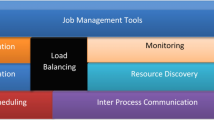Abstract
Distributed object computing systems are widely envisioned to be the desired distributed software development paradigm in the near future due to the higher modularity and the capability of handling machine and operating system heterogeneity. Indeed, enabled by the tremendous advancements in processor and networking technologies, complex operations such as object serialization and data marshalling become very efficient, and thus, distributed object systems are being built for many different applications. As the system scales up (e.g., with larger number of server and client objects, and more machines), a judicious load balancing system is required to efficiently distribute the workload (e.g., the queries, messages/objects passing) among different servers in the system. Several such load balancing schemes are proposed recently in the literature. However, while the rationales and mechanisms employed are dramatically different, the relative strengths and weaknesses of these approaches are unknown, making it difficult for a practitioner to choose an appropriate approach for the problem at hand. In this paper, we describe in detail three representative approaches, which are all practicable, and present a quantitative comparison using a real experimental distributed object computing platform. Among these three approaches, namely, JavaSpaces based, request redirection based, and fuzzy decision based, we find that the fuzzy decision-based algorithm outperforms the other two considerably under a wide range of different practical scenarios.
Similar content being viewed by others
References
S. Ahuja, N. J. Carriero, and D. H. Gelernter. Matching language and hardware for parallel computation in the Linda machine. IEEE Trans. Computers, 37(8):921–929, August 1988.
V. Cardellini, M. Colajanni, and P. S. Yu. Dynamic load balancing on Web-Server systems. IEEE Internet Computing, 3(3):28–39, May/June 1999.
T. L. Casavant and J. G. Kuhl. A taxonomy of scheduling in general-purpose distributed computing systems. IEEE Trans. Software Engineering, 14(2):141–154, February 1988.
L.-S. Cheung. Load Balancing in Distributed Object Computing Systems, M.Phil. Thesis, Department of Electrical and Electronic Engineering, The University of Hong Kong, August 2001 (available online at: http://www.eee.hku.hk/~ykwok/students/thesis-mphil-CheungNelson.pdf).
L.-S. Cheung and Y.-K. Kwok. A fuzzy load balancing service for network computing based on Jini. Proceedings of EURO-PAR'2001, 183–190. Manchester, United Kingdom, August 2001.
C. W. Cheong and V. Ramachandran. Genetic based web cluster dynamic load balancing in fuzzy environment. Proceedings of the 4th International Conference on High Performance Computing in the Asia-Pacific Region, pp. 714–719, May 2000.
A. Choudhary and T. V. Prabhakar. TransWeb: A framework for development of transparent loadbalanced web applications. Proceedings of the International Symposium on Distributed Objects and Applications (DOA'2001), 85–93, September 2001.
K.-P. Chow and Y.-K. Kwok. On load balancing for distributed multi-agent computing. IEEE Transactions Parallel and Distributed Systems, 13(8):787–801, August 2002.
P. Chulhye and J. G. Kuhl. A fuzzy-based distributed load balancing algorithm for large distributed systems. Proceedings of the 2nd International Symposium on Autonomous Decentralized Systems, 266–273, April 1995.
M. Colajanni and P. S. Yu. A performance study of robust load sharing strategies for distributed heterogeneous web server systems. IEEE Transactions Knowledge and Data Engineering, 14(2):398–414, March/April 2002.
S. M. Bhandarkar and H. R. Arabnia. Parallel computer vision on a reconfigurable multiprocessor network. IEEE Transactions Parallel and Distributed Systems, 8(3):292–309, March 1997.
E. Freeman, S. Hupfer, and K. Arnold. JavaSpaces: Principles, Patterns, and Practice, Addison-Wesley, 1999.
Hosta White Paper, Concept Technologies Ltd., 2000.
C.-J. Hou and K. G. Shin. Implementation of decentralized load sharing in networked workstations using the condor package. Journal of Parallel and Distributed Computing, 40(2):173–184, February 1997.
IBM's TSpaces, http://www.almaden.ibm.com/cs/TSpaces, 2003.
Jini Connection Technology, Jini Technology Core Platform Specification, http://www.sun.com/jini/ specs/jini1_1spec.html, 2003.
Jini Connection Technology, JavaSpaces Service Specification, http://www.sun.com/jini/specs/ jini1_1spec.html, 2003.
V. Kalogeraki, P. M. Melliar-Smith, and L. E. Moser. Dynamic migration algorithms for distributed object systems. Proceedings of the 21st International Conference on Distributed Computing Systems (ICDCS'2001), 119–126, April 2001.
W. Keith. Core Jini, Prentice Hall, 1999.
B. Kosko. Neural Networks and Fuzzy Systems: A Dynamical Systems Approach to Machine Intelligence, Prentice Hall, New Jersey, 1992.
T. Kunz. The influence of different workload descriptions on a heuristic load balancing scheme. IEEE Transactions Software Engineering, 17(7):725–730, July 1991.
A. Leff and P. S. Yu. A performance study of robust distributed load sharing strategies. IEEE Transactions Parallel and Distributed Systems, 5(12):1286–1301, December 1994.
P. Mehra and B. Wah. Synthetic workload generation for load-balancing experiments. IEEE Parallel and Distributed Technology, 3(3):4–19, Autumn/Fall 1995.
H. T. Nguyen, N. R. Prasad, C. L. Walker, and E. A. Walker, eds., A First Course in Fuzzy and Neural Control, CRC Press, 2002.
OpenSpaces, http://openspaces.exolab.org/, 2003.
N. G. Shivaratri, P. Krueger, and M. Singhal. Load distributing for locally distributed systems. IEEE Computer, 25(12):33–44, December 1992.
B. D. Silaghi and P. J. Keleher. Object distribution with local information. Proceedings of the 21st International Conference on Distributed Computing Systems (ICDCS'2001), 381–388, April 2001.
Y.-M. Wang and P.-Y. E. Chung. Customization of distributed systems using COM. IEEE Concurrency, 6(3):8–12, July–September 1998.
J. Watts and S. Taylor. A practical approach to dynamic load balancing. IEEE Transactions. Parallel and Distributed Systems, 9(3):235–248, March 1998.
WebStone, http://www.mindcraft.com/webstone/, 2003.
Rights and permissions
About this article
Cite this article
Cheung, Ls., Kwok, Yk. On Load Balancing Approaches for Distributed Object Computing Systems. The Journal of Supercomputing 27, 149–175 (2004). https://doi.org/10.1023/B:SUPE.0000009320.90845.0c
Issue Date:
DOI: https://doi.org/10.1023/B:SUPE.0000009320.90845.0c




